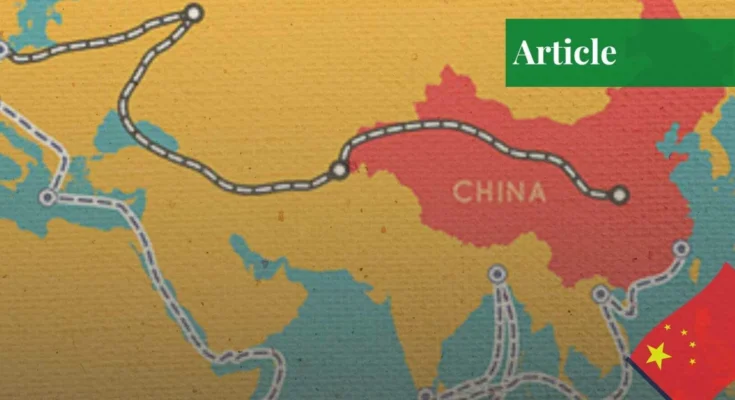The Belt and Road Initiative (BRI) is one of China’s most ambitious and far-reaching economic policies, aimed at enhancing global trade and infrastructure development. Launched in 2013 by Chinese President Xi Jinping, the BRI seeks to revive the ancient Silk Road trade routes, connecting Asia, Europe, and Africa through a vast network of transportation, energy, and digital infrastructure. Often referred to as a “modern Silk Road,” the initiative aims to bolster trade, promote global economic development, and extend China’s influence on the international stage. In this article we see what experts like Kavan Choksi say.
Core Goals of the Belt and Road Initiative
At its core, the BRI has two main components: the Silk Road Economic Belt, which focuses on overland infrastructure linking China to Europe through Central Asia, and the Maritime Silk Road, which seeks to establish shipping routes across Southeast Asia, South Asia, and Africa. The initiative spans more than 60 countries and aims to create a trade network that boosts connectivity across continents. By investing in ports, highways, railroads, energy projects, and telecommunications networks, China envisions a new era of global trade with itself at the center.
Economic Impact on China
One of the key economic motivations behind the Belt and Road Initiative is to ensure China’s continued economic growth and stability. China has faced slowing economic growth in recent years, driven in part by a shift away from its traditional export-driven model. The BRI allows China to diversify its economic activities, opening new markets for Chinese goods and services while securing resources from participating countries. By developing infrastructure in less-developed regions, China can enhance trade routes, reduce transportation costs, and create stronger trade partnerships, which, in turn, fuel its domestic economy.
Moreover, the BRI helps address China’s excess capacity problem, particularly in sectors like steel, cement, and construction. Through infrastructure projects abroad, Chinese companies are able to export their expertise, labor, and materials, thereby stabilizing industries that might otherwise face overproduction or reduced demand. By investing in infrastructure projects overseas, China ensures continued demand for its materials, benefiting its domestic industries while fostering closer ties with participating nations.
Impact on Participating Countries
For countries involved in the Belt and Road Initiative, the economic benefits can be substantial. Many developing nations that struggle with outdated or inadequate infrastructure see the BRI as an opportunity to modernize. Countries across Asia, Africa, and Eastern Europe have welcomed Chinese investments in transportation, energy, and technology projects, as these investments are seen as essential for boosting economic growth, increasing trade, and improving the quality of life for their citizens.
For example, countries like Pakistan and Kenya have seen significant infrastructure development as a result of BRI-related projects. Pakistan’s Gwadar Port and the China-Pakistan Economic Corridor (CPEC) are key BRI initiatives that have the potential to transform the country’s economic landscape by improving its connectivity with China and other global markets. Similarly, Kenya’s Mombasa-Nairobi railway, funded and constructed by China, aims to stimulate trade in East Africa.
However, not all impacts are universally positive. Critics argue that some countries may become economically dependent on China due to the large-scale loans associated with BRI projects. There is concern that nations with limited financial resources might struggle to repay these loans, leading to “debt traps” where countries are forced to cede control of key infrastructure or resources to China. An example of this is Sri Lanka, which, unable to pay back loans for the construction of Hambantota Port, agreed to lease the port to a Chinese state-owned company for 99 years. Such instances have raised concerns about the political and economic sovereignty of countries participating in the BRI.
Global Trade Implications
The Belt and Road Initiative has the potential to reshape global trade patterns by creating more direct and efficient trade routes between Asia, Europe, and Africa. By improving infrastructure, China aims to enhance the flow of goods and services across continents, reducing transportation costs and increasing trade volume. In particular, the overland routes linking China to Europe through Central Asia could reduce reliance on maritime shipping lanes, making trade faster and more reliable.
For China, the BRI also serves as a tool to mitigate the risks associated with geopolitical tensions, especially those surrounding key maritime routes such as the South China Sea or the Malacca Strait. By establishing new overland routes, China can diversify its trade options and reduce its vulnerability to potential disruptions in these contested regions. This diversification strengthens China’s trade security and extends its influence into landlocked regions like Central Asia and Eastern Europe, areas historically less connected to global trade networks.
Challenges and Criticisms
Despite its ambitious goals, the Belt and Road Initiative faces several challenges. Financially, the scale of the project is enormous, with estimates suggesting that the BRI could cost trillions of dollars over its lifetime. This raises questions about the long-term financial viability of the initiative, particularly given the large sums involved in loans to developing countries that may struggle to repay them.
Additionally, there is criticism regarding the transparency of BRI projects. Some projects have been marred by allegations of corruption, lack of environmental safeguards, and failure to consult local communities. Furthermore, as China’s geopolitical influence expands through the BRI, concerns about political leverage, dominance, and “soft power” have been raised by countries like the U.S. and India, which view the initiative as a strategic tool for China to expand its global influence.
Conclusion
The Belt and Road Initiative is a transformative project that aims to reshape global trade and economic development. By investing in infrastructure across continents, China seeks to open new markets, enhance trade routes, and strengthen its global economic presence. While the BRI presents significant opportunities for economic growth and development, particularly in underdeveloped regions, it also faces challenges related to debt dependency, transparency, and geopolitical tensions. As the initiative continues to unfold, its long-term economic and political impact will shape not only China’s future but also the global economy for decades to come.





